Pressurised Mating Adaptor (PMA1)
From the FGB, moving toward the bow, we pass through a corridor that looks rather strange. The corridor is an asymmetrical truncated cone. Starting from the round hatch, it transforms into a square that is Node-1. This transitional area is called PMA1, and in addition to connecting the two main segments, it is also a convenient place to store things: its walls are covered with the typical white bags we call CTBs that contain equipment on the Station. When you float through the PMA1 it feels as though you are going down because of its asymmetrical shape .
Node-1 (Unity)
This is the oldest module of the American segment and you can tell by the state of the of the walls that have suffered from dozens of inexperienced astronauts eating meals here. Node-1 is still the main meeting point for the crew, and the only passage from one segment to another . The table here is the missing half of the Russian table mentioned in my previous post. The table was disassembled several expeditions ago and reassembled here with wit and some space do-it-yourself. The four walls around the table are used as stowage. The deck , in particular, contains the Station’s toolbox , so it is normal to see an astronaut selecting tools for a job or storing them here when finished. The walls are made of a white, plastic material except for the structures on the four sides of the hatches which are pink to distinguish them from the blue-coloured Destiny Lab and the grey Node-2. Node-1’s second bay has four access hatches to the modules but only three are related to other areas. The fourth, at the very top, is used for storage and currently it holds categorised food containers.
Permanent Multipurpose Module (Leonardo)
Crossing the Unity hatch at the nadir you access the Permanent Multipurpose Module, or PMM. Also called Leonardo, the name of this module has an interesting history. Built by the Italian Space Agency, the module began life in space as one of three logistic modules carried by the Space Shuttle to resupply the Station. The Italian Space Agency then converted MPLM to a permanent storage module. Here the feeling of going down is very strong, and we all play at ‘falling’ into the PMM and then bouncing back by pushing off from the bottom. The walls of Leonardo are stowed with CTBs, spare parts and food. One of the racks is allocated to the astronauts, we use it as a personal locker: our clothes, personal hygiene material and other belongings are here.
Airlock (Quest)
If you move to the right from Node-1 , looking in the flight direction, you enter the Airlock. I have described this module many times, because during my first spacewalk I spent lots of time preparing the spacesuits which are installed in the two walls of the Equipment Lock. The two suits are waiting patiently for the next astronaut to bring them to life. A smaller cylinder – the Crew Lock – is used as storage for spacewalk material when not used for a spacewalk itself. Our reserve suits, the SAFER and tethers are attached to its walls . The rest of the material is behind the four walls of the Equipment Lock: batteries for the suit , CO2 filters, drinking-water containers and maintenance tools. The Airlock will always have a special aura for me: it is particularly quiet and cosy because it is smaller than the other modules and I always love working here .
Node-3 (Tranquility)
Directly in front of the Airlock is Node-3 . Without doubt this module has the highest number of astronauts pass by each day, for a variety of reasons. Perhaps this module is the less noble one but certainly one of the most useful and very essential as it holds the toilet. It is identical to the Russian toilet, the liquid recycling system is fully integrated and astronauts intervention is minimal. The cabin dimensions are more comfortable than the toilet at the other end of the Station , and Fyodor likes to joke that our toilet is the “first class” toilet.
The second reason why this module is particularly busy is that two of our sports equipment are installed here. The first one – T2, or better known as our treadmill – is on the right wall as you enter from Node-1. We run on the wall that looks towards our flight direction meaning that our body is parallel to Earth. I wrote about T2 in a previous blog. The second sports equipment is called the Advanced Resistive Exercise Device – ARED – and it works on the principle of vacuum pumps : two sealed and calibrated pistons allow us to exercise weight lifting. The detail I want to point out here is that the three elements of Node-3 described so far lie on three different levels: if an astronaut in Node-1 looks inside Tranquility, they could see an astronaut running parallel to the deck, another using the toilet in normal orientation (i.e. with their head towards the zenith) and another astronaut training on ARED head down. Because each of us trains on ARED at least 90 minutes a day, and at least two people, if not three , train daily on T2, it is very likely that someone, at any given time is training .
Cupola
The third reason why there is always someone in Node-3 is because of Cupola which is installed on the nadir port. As you cross Node-3 while doing a 180-degree somersault you will enter Cupola. Often our feet remain hooked to the hatch so Earth flows towards us, our view looking in the direction of flight, with North on the right and South on the left. This window on the world has fascinated and charmed all astronauts and cosmonauts who have had the privilege of looking at our planet from up here. Its seven windows allow a view of 360 degrees of the horizon and offers a spectacle of unparalleled beauty that nourishes the soul and fills the eyes without ever being indulging.
I could go on trying in vain to find the right words, but this is not the right moment. So we move back, through Node-3 and through Node-1 to continue past the hatch in the flight direction.
Destiny Laboratory (Lab)
Entering the American laboratory the size of the module is surprising, it is at least twice as large as the modules described so far. The two cone-shaped areas to the front and rear are blue, but the rest of the walls are white (or rather, what we can see of them!). The Lab is the core of the US segment , not only because it contains most of the systems that support life on the Station but also for the scientific racks distributed along the surfaces: we carry out many experiments here. As you enter, on the right, you will find many lenses and cameras that are always available for us to take pictures of our activities. To the left is a workplace used for the Daily Planning Conferences where the logbook can be found (in fact it is a completely unofficial note book), along with pens, markers and pencils, all attached with Velcro. Immediately after that, on both sides, are control joysticks for Canadarm2. The Lab is the support location for the robotic operations when the one in Cupola is not used. Only the robotic work station to the left is operational, the one to the right is connected to the training system called ROBOT, a Canadarm2 simulator.
Further on, we will see the drinking water dispenser overhead, then, to the left, CEVIS, our space exercise bike . It takes little time to adapt to cycling in orbit but it is always strange to think that CEVIS has no saddle or handlebar: they are useless at 0g. The other four bays on the right-hand side are occupied by science racks including the easily recognisable Microgravity Science Glovebox with its large glass window now running the InSpace3 experiment.
Node-2 (Harmony)
Identical in shape to Node-3 (they are both built in Italy) , Node-2 contains four sleeping berths where astronauts (and a cosmonaut!) rest. To ensure a bit of space, the berths are placed away from the walls. Slightly smaller than a phone booth (for those old enough to remember them) these ‘phone boxes’ are a luxury in orbit because they allow a little privacy. Inside each, bound to the interior wall, we have our light-green sleeping bags and two computers (one for the onboard network and one to connect to the internet). On the walls, each astronaut arranges photos of their family and personal belongings the best they can – all this helps to create a welcoming and comfortable environment.
The second bay is a working area, and the walls are fitted with two blue, metal benches for tools, equipment and experiments. This is where Karen and Mike are working on the CFE experiment. The docking port at the nadir is now empty but has hosted HTV-4 and Cygnus -D over the course of my mission. This is also where Dragon docks. The upper door is empty, while the front is used for stowage. Behind that door is PMA2 , the Space Shuttle docking port: every time I think about PMA2 I see myself installing the insulating cover on the outside during my first spacewalk… but that is another story .
Japanese Experiment Module (Kibo)
A small, Japanese-style curtain welcomes us when we turn to the left to enter Kibo . If the Destiny Lab is large, Kibo is huge , as the inscription at the entrance confirms: “Welcome to Kibo – please enjoy and relax in this brand new , spacious and the most quietest room in the ISS ” (sic). Always immaculate , spacious and well lit, Kibo is a favourite place for filming videos. Here, too, the walls offer stowage and experiment areas but four features make Kibo even more extraordinary : first, the last bay on the left has a robotic station (with integrated joystick and screens) to control the Japanese robotic arm on the Exposed Facility outside (the so-called veranda). Second is an integrated sealed chamber to move experiments to outside the Station and vice-versa . The third feature are the two windows just above the sealed chamber that look to the right of the Station. To discover the fourth feature we have to cross the entire module to the wall at the very end. Here the module widens and you will find another pressurised module when you look up.
Experiment Logistics Module- Pressurized Section (JLP)
The JLP is a (relatively) small pressurised logistics module on top of Kibo. It is much loved by astronauts to film scenes where we fly upward to demonstrate microgravity. The words “Welcome to the highest place of Japan over Mt Fuji” are written at the entrance which always puts a smile on our faces. The module is the same size as an HTV and is full of materials stowed like in an HTV spacecraft.
Columbus Laboratory
Crossing Kibo in the opposite direction to return to Node-2 and moving across, we find ourselves in the Columbus laboratory , the European contribution to the International Space Station. When you get inside, you immediately realise the scientific nature of this module: all the bays to the right are occupied by experiment racks as well as the first bay above us and three to our left. The deck is dedicated to onboard systems and is covered by metal panels. Besides containing systems including two monitors, the cone in front of us is used for stowage. In addition to being used for European experiments, Columbus is also the most used module for physiology studies and checks are performed on weight changes, blood samples are taken and all types of ultrasounds are performed (spinal , cardiac and optical) .
Since our journey on the Station began we have crossed many tens of metres and visited a volume of about 840 cubic meters – equivalent to that of a large transport aircraft. This extraordinary ship , built and operated by five space agencies (the best example of international cooperation in the world) travels at an altitude of 400km and 28 000km per hour. A student asked me “What is the thing that most impressed you the Space Station?”. Now you can understand my answer. And you, what would you have answered?

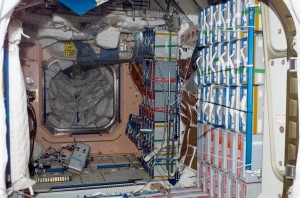
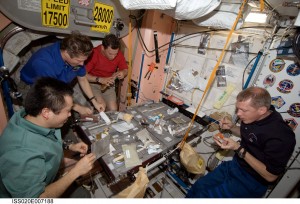
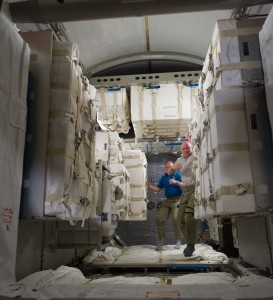
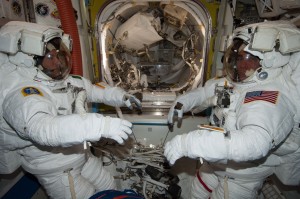
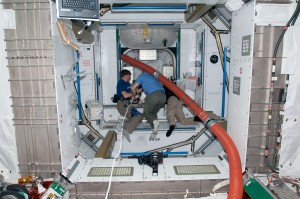
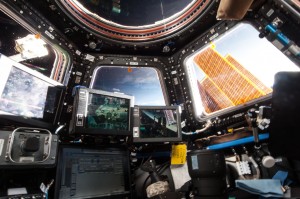
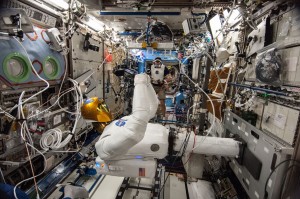
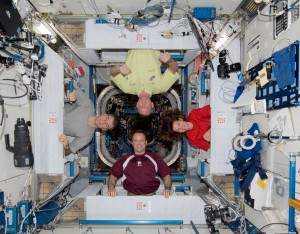
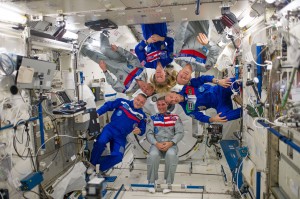
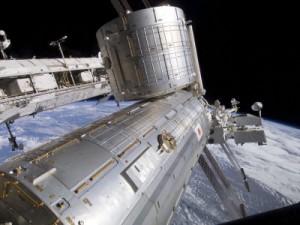
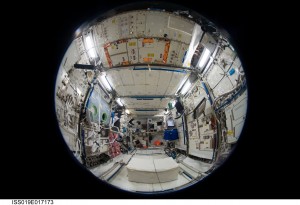


Discussion: 27 comments
Dopo sei mesi, tutte le parole possibili sono già state dette e ridette,per cui avrei paura di cadere nel ridicolo.
Ma vorrei che te ne rimanessero due nel cuore.
Complimenti e … grazie
(Avrei risposto: la sua Grandezza. E non solo riferendomi alle dimensioni…)
Quella descritta in questo post è sicuramente la parte più bella. Siamo partiti dalla coda per arrivare alla testa. Anzi, agli occhi! 😉
In quelle “stanze” abbiamo condiviso quasi metà anno. Sembra sia passato in un attimo, ma se ci pensi è davvero tanto. Quante ne abbiam dette? Ricordo il weekend in cui sono venuta su: la Spacemaid, le arancine al Cigno, le finestre della Cupola pulite indossando la tua EMU… a chi legge potrebbe sembrare pazzia, io dico che è magia. Sono dei ricordi anche questi, no? Dei bellissimi ricordi, proprio tra quei moduli, tra quei cavi, nell’Airlock, sbirciando da quelle finestre… :’) Perché in fondo, ci sono stata davvero lassù, con voi: con i mitici della 36, e adesso con quelli del 37° piano. Tra poco mi tocca scendere, lo so. Ma dalla ISS, non dal Sogno.
Come ho sempre ammesso, se non fossi stato siciliano io non sarei qua. Saresti rimasto un Guidoni, un Vittori, un Nespoli… seguito, distrattamente, nei vari Tg. Che ragazzo fantastico mi sarei persa? Una persona che, giorno dopo giorno, mi ha dato, senza chiedere nulla in cambio. (anche perché non potrei ripagarti in nessun modo, per tutto quello che mi hai donato) Sei entrato nelle nostre case in punta di piedi, nel quotidiano di tutti noi, con semplicità, umiltà e gentilezza… un Signore con la “esse” maiuscola. Mettendoci a disposizione il tuo tempo, ascoltandoci, parlandoci, regalandoci un sorriso. Tutto questo sembra facile, sembra scontato, ma non lo è affatto! Potevi benissimo non farlo, scegliendo di postare qualche foto, scrivendo qualche riga ogni tanto, e stop. Invece hai scelto di condividere, oltre al tuo Sogno, te stesso. Questa io la chiamo Fortuna. Fortuna di averti incrociato nel mio cammino… arrivato per caso, dal nulla, come “un premio” non meritato. La tua professionalità, la tua serietà, la tua saggezza, la tua umanità, il tuo cuore… a nostra disposizione… amico fedele delle nostre giornate, per tutti questi mesi. Cosa puoi dire ad una persona così? Come puoi far finta di nulla e farti scivolare tutto, senza affezionarti? Come puoi restare indifferente ad un’esperienza di tale portata? Semplice, non puoi.
“siamo in orbita, e ogni giorno è il giorno più bello che si possa sognare.”
Anche sulla Terra, Lù! Credimi.
E lo è stato, per quasi 6 mesi, solamente GRAZIE a te.
Che dire s’ignori… mi sa che in confronto, la tragedia dell’abbandono di Ron Moss (per i pochi che non lo sapessero), alias Ridge Forrester nel cast di Beautiful, questo gli fa davvero un baffo…
E che dire a te caro Luca, dopo il tutto detto e stra detto e ribadito a menadito da tutti. Nulla di più se non invocarti un’unica ultima accorata supplica… Sempre che tu voglia o possa farci un’ultima grazia, tra un preparativo e l’altro, prima della grancassa, del finale a rientro, dell’uscita di scena… Ti è per caso possibile far (ancora) qualcosa per evitare il drammatico epilogo scontato di pacchetti di kleenex acquistati in s’offerta speciale al discount, da queste povere anime belle “vedove bianche” inconso-labili, che già ti rim-piangono amaramente in anteprima e in diretta, nonostante tu non ti sia ancora eclissato ? No, perchè, sapessi… per la cronaca… in questi giorni, in queste ore, qui il morale, “a terra” … sembra ci sia stata una moria di gatti… Scene isteriche, lutti, amarcord, pianti e strappi di vesti, oltre a montagne di missive inviate per prenotarsi a sup-posta per te chè chissà mai che magari tra vent’anni da Maria si leverà ‘a bbusta e ti faranno una bella rugosa, ops, sugosa sopresa… Eh sì, sapessi Luca che grande tristezza, leggere di tante e tante e troppe “donne” che nonostante, l’emancipazione, i tempi moderni e soprattutto il famoso vecchio slogan “è mia e me la gestisco io”, ancora si fanno gestire anima e cuore dal mito, ancora idealizzano l’ideale di “principe azzurro” di Uomo eroe, realizzandosi infondo col nulla, nel nulla, senza null’altro di meglio d’essere e fare in realtà che innamorarsi perdutamente dell’astronauta o dell’attore di soap del momento… Già; quella poi del “se tu non fossi stato siciliano, non sarei qui”… Non fosse tanto scialba, oltre che per certi vesi razzista, come ab-battuta, si potrebbe considerarla anche comica, se non addirittura esilarante… Anche se in Verità già immagino… se invece di Parmitano l’astronauta, fossi stato un anonimo operatore ecologico di Canicattì… la s’ignora dove sarebbe ora. Ma d’altronde, tant’è; chi più chi meno, da ogni parte d’Italia, in rete e chissà forse anche su Marte, così infondo fan tutte… Però s’ignori… davvero che gran pena… per tutte queste donne vittime schiave del mito eroe…
In questo testo brillante e scoppiettante non vi sembra di sentire come una nota stonata, un leggero tanfo… d’invidia? o è solo una mia impressione?
Grande Luca, che la tua avventura certamente non finisce qui.
Dirti che è stata un’esperienza fantastica seguirti nel tuo straordinario viaggio è solo quanto il lessico consente, racchiudendo nel giudizio le emozioni, l’incredulità , la sorpresa ,il divertimento e tanto altro che ha accompagnato questo atteso incontro quotidiano. C’è in effetti tantissimo di inespresso che riguarda l’orgoglio di essere conterranei, siciliani e italiani, lo straordinario senso della scoperta dei cieli, e la nostra geografia “au revers”, luoghi mai visti, e mai così. E poi il tuo raccontare leggero, parole di un linguaggio fra Rodai e Calvino, ma soprattutto ,tuo! La novella sullo spuntino con Wasabi, letta in classe, ed è piaciuta a tutti. E oggi questa Guida. Grazie, ….e un saluto.
Avrei risposto:
“Chiudi gli occhi, apri la mente, ascolta e …. immagina! anche tu fai ormai parte dell’equipaggio, e quindi dimmi tu cosa ti ha colpito?” 😉
In questi quasi sei mesi, siamo stati visitatori e/o ospiti della Stazione Spaziale; abbiamo imparato gli orari, il modo di muoversi, di parlare, di mangiare, di fare sport, di intrattenersi con foto, musica ed altro; ancora non siamo bravi nelle sperimentazioni, ma piano piano, forse, qualcuno di noi ci riuscirà ;)!!!
Abbiamo ricevuto tanto da te!
E se qualcuno mi facesse la domanda “Cosa ti ha colpito di più in Luca?”, risponderei immediatamente “il sorriso, il carattere spiritoso, l’umanità, la professionalità”!
Ti auguro un buon rientro a casa e tanti altri viaggi in giro per lo spazio 🙂 :-).
Un affettuoso abbraccio
Maria Teresa
thank you for sharing! — Grazie per la condivisione! — Спасибо за обмен! — 共有していただきありがとうございます !
Luca ,perfetta guida..questa è la prima galleria d’arte tecno/scienzale che visito con fascinosa curiosità,rapita.. ti ringrazio per il tempo che ci hai dedicato ..raccontata da dentro è un’altra cosa..inoltre le tue qualità /professionalità saltano sempre fuori- beh.. se dovessi entrare e sostare ,io che apro e studio -monto e smonto qualsiasi cosa mi capiti a tiro non saprei da dove iniziare vista l’immensa offerta 🙂 , nei 2 laboratori ci potrei vivere all’infinito, niente di più stmolante ,andando a prendere una boccata di mondo ogni tanto….GRAZIE 😉
Ciao Luca, io non posso fare a meno di notare qui una serie di nomi Italiani:
– Luca Parmitano – Medaglia d’Argento al Valore Areonautico
– Leonardo – Permanent Multipurpose Module
– Colombo – Columbus Laboratory
– Cupola – Finestra sul mondo
– Volare – Missione
Tutto questo mi fa pensare immediatamente al testo di una canzone, molto nota per la verità. I suoi Autori , Domenico Modugno e Franco Migliacci impiegarono alcuni mesi per riuscire infine a comporla. Un successo mondiale, come Voi lassù.
Nel blu, dipinto di blu
Domenico Modugno
Penso che un sogno così non ritorni mai più;
mi dipingevo le mani e la faccia di blu,
poi d’improvviso venivo dal vento rapito
e incominciavo a volare nel cielo infinito…
Volare… oh, oh!…
Cantare… oh, oh, oh, oh!
Nel blu, dipinto di blu,
felice di stare lassù.
E volavo, volavo felice più in alto del sole ed ancora più su,
mentre il mondo pian piano spariva lontano laggiù,
una musica dolce suonava soltanto per me…
Volare… oh, oh!…
Cantare… oh, oh, oh, oh!
Nel blu, dipinto di blu,
felice di stare lassù.
Ma tutti i sogni nell’alba svaniscon perché,
quando tramonta, la luna li porta con sé.
Ma io continuo a sognare negli occhi tuoi belli,
che sono blu come un cielo trapunto di stelle.
Volare… oh, oh!…
Cantare… oh, oh, oh, oh!
Nel blu, dipinto di blu,
felice di stare quaggiù.
E continuo a volare felice più in alto del sole ed ancora più
su,
mentre il mondo pian piano scompare negli occhi tuoi blu,
la tua voce è una musica dolce che suona per me…
Volare… oh, oh!…
Cantare… oh, oh, oh, oh!
Nel blu, dipinto di blu,
felice di stare quaggiù.
Nel blu degli occhi tuoi blu,
felice di stare quaggiù,
con te!
Grazie. Con te abbiamo avuto la possibilità di fare un’esperienza davvero straordinaria che non dimenticheremo mai. Ti vogliamo veramente tanto bene. Grazie… grazie… grazie, Luca!
I love reading your blog entries, and living vicariously through your experiences, Luca! I’ll be sad to not be able to read them anymore, and I’m sure it is bittersweet for you, too, to have this amazing adventure nearing its end. Enjoy your last few days on the ISS, safe travels home to Kathy and your girls, and hopefully I’ll see you at the MVHS reunion in a couple years! 🙂
Destiny Laboratory (Lab) e todas as divisoes da estaçao espacial me fazem enxerguar as verdades para se estar no vácuo
In questi mesi hai fatto crescere tutti noi sulle conoscenze della stazione,le foto uniche ci hanno appiccicato al monitor per tantissime ore.Sui complimenti è stato scritto di tutto.Da parte mia per non ripetermi ti voglio solo dire GRAZIE. Una cosa ancora te la voglio chiedere:Per me sei diventato un componente della famiglia,ma tu come preferisci essere chiamato.Luca o con il grado che ti sei guadagnato.Ciao e buon rientro a terra.
Grazie per la possibilita che condividete con noi quaggiu di trasmettere ai ragazzi la passione per materie importanti per il futuro ai nostri ragazzi, anche quelli meno fortunati! Grazie per le iniezioni di speranza e di amore che riceviamo da tutti voi! Soprattutto grazie per la realizzazione di un lavoro cosi futuristico e che ci riempie di fiducia!
Buon rientro a casa e ogni bene
Ernestina
Pianura padana Italia
Buonasera Luca,
le parole più belle le ha dette lei in questi mesi…
Le mie sarebbero solo un ripetersi.
Rispondo però alla sua domanda:
” Cosa mi ha colpito di più della Stazione Spaziale?”
Sapere cos’è una Stazione Spaziale.
Sapere che i Nodi non sono quelli marinari o quelli che vengono al pettine, sapere che Eva non è solo un nome di donna e Emu non è il nome di un animale senza accento, sapere che l’interno non è freddo e asettico come quello che immaginavo, sapere che la Cupola non è solo quella di San Pietro a Roma e moltissime altre cose ancora…
Grazie per averci fatto sentire il suo cuore pulsante.
Buon rientro e …non ci dimentichi…troppo in fretta.
Silvia Benvenuto.
Tutto fantastico, tu sei un grande e mi sono emozionato a vedere le tue foto ma ‘sta cosa devo proprio chiedertela : il bagno dov’è ? 🙂
Semplicemente… GRAZIE!!!
E’ stato bello leggerti e vedere il mondo dal tuo punto di vista, è stato bello azzardare un saluto e scoprire la mattina dopo che avevi risposto, è stato bello sapere di avere un amico tra le stelle che ci apriva un mondo sconosciuto…
Ci sono tante immagini, tante tue parole che mi hanno colpita in questi mesi, oggi questa in particolare mi ha commosso: “… Le sue sette finestre che guardano a 360 gradi sull’orizzonte offrono uno spettacolo di ineguagliabile bellezza, che nutre l’anima e riempie gli occhi senza mai saziarli…”: grazie a te ho potuto godere di questa ineguagliabile bellezza che ha riempito i miei occhi senza mai saziarli!!!
Buon rientro a casa Maggiore, con tutto l’affetto e l’ammirazione possibile,
Isabella
Io ero la’, in mezzo al pubblico della conferenza per l’ATV-4, dopo essere riuscita ad entrare quasi per miracolo in quell’aula troppo piena, dalla quale troppi studenti sono rimasti chiusi fuori. Ho aspettato ore per vederti, più di quelle previste, ma a stento me ne sono accorta. Ho sentito io stessa quella domanda e in quel momento mi sono chiesta, tra me, che cosa avresti risposto…
Ma tra tutte le cose impressionanti della ISS, hai senz’altro scelto la migliore: l’unica che in fondo le riassume tutte. Non potevi scegliere nulla di meglio.
Grazie del tuo entusiasmo e della tua fiducia. Non ti deluderemo 🙂
Buon rientro sulla Terra! Vieni a trovarci a Milano qualche volta!
Sara Zanzottera
grazie Luca per averci accompagnati durante questi mesi nella tua straordinaria avventura spaziale regalandoci stupende immagini del nostro pianeta, dedicandoci tanto del tuo tempo prezioso. Buon ritorno a casa Luca, penso che la tua famiglia ti sta aspettando con tanta gioia e trepidazione. Ciao Astro Luca!!!
Purtroppo sta per concludersi un’avventura durata circa 6 mesi… Non so voi, ma io mi sono sentito partecipe delle missioni di Luca, Karen e di tutti gli altri.
Per me è stato un vero onore seguirti, “osservarti” e leggerti… E’ incredibile quante emozioni riesca a trasmettere una persona… Luca, tu ci hai regalato il tuo tempo, e questa non è cosa comune.
Ti ho detto tanto in questi 6 mesi, e ho paura di ripetermi, ma… Meriti tutta la mia stima e il mio affetto. Seguirò in diretta streaming il tuo rientro. Non posso mancare…
Alla domanda su cosa mi avesse colpito della Stazione Spaziale Internazionale, avrei risposto: La sua grandezza, la sua utilità e soprattutto il suo straordinario equipaggio…
Ti vogliamo bene…
Grazie di tutto!
” Cosa mi ha colpito di più della Stazione Spaziale?” La sua grandezza e il livello di tecnologia dei vari dispositivi: in tutti questi anni è diventata una “stella” visibile a occhio nudo dalla terra capace di ospitare per lunghi periodi la vita umana. La possibilità di visitare virtualmente la Stazione Spaziale , osservare le varie attività di routine, interagire con astronauti come te SuperLuca che esprimi la tua passione per l’avanscoperta è un’opportunità di un valore inestimabile.
Interessantissima e utile spiegazione della ISS ………..mi piacerebbe tanto poterci soggiornare qualche giorno. Lo spazio e tutto il programma spaziale mi ha sempre attratta da quando ero piccolo (ora ho 66 anni e pratico l’hobby del radioamatore dal 1964).
Cordiali saluti a te caro Luca Parmitano e a tutti i tuoi colleghi astronauti.
Hi Luca, Karen, and Fyodor, Wow, only a couple more days and all of you will be back on earth! I am sure you all have mixed emotions, but I bet you will be so very happy to see your spouses, children and home sweet homes. Six months sure goes by fast. I have enjoyed all of your great twitter posts and photos. Earth is such a miracle!
Godspeed on your return!
“Ciao Luca”! Soon WELCOME! Què sueño tan hermoso has vivido… para festejarlo toda una vida. Ya lo dijo Julio Verne; ” QUE SIEMPRE LA RELIDAD SUPERARÀ A LA FICCION”.- Un abrazo.-
Grazie Luca per le emozioni che ci regali! 😉
Mi rende il cuore pieno di gioia sapere che ci sei tu che rappresenti l’Italia, il nostro paese, in una missione internazionale. Un dato di fatto che ci rende orgogliosi di essere italiani in un momento così brutto per il nostro paese come quello che stiamo passando in questi ultimi anni.
I tuoi racconti nel Blog mi rapiscono e mi portano in un’altra dimensione, in un universo parallelo al nostro. Sembra che il tempo si sia fermato con te, lontano dalla frenesia delle attività quotidiane qui sulla Terra.
La felicità più grande è stata questa estate, in Agosto, ero in vacanza in Alto Adige e ho visto passare la ISS a folle velocità come un puntino luminoso nel cielo stellato, è stata un’emozione unica, e guardandola ti ho pensato, ho pensato al vostro equipaggio! 🙂
CIAO.
FATE BUON VIAGGIO.
Lidia
Grazie Luca, della accurata descrizione della vita di bordo, che stai affrontando insieme ai tuoi colleghi, ed alle foto delle varie apparecchiature alle pareti della stazione; una cosa ,però che non ho visto, sono le radio e la telecamera del progetto HAMTV, oppure una loro breve descrizione.
Grazie di nuovo, ma sai, ho già preparato presso la mia stazione radioamatoriale il sistema per la ricezione delle Vostre prossime immagini in diretta nei futuri collegamenti dell’ ARISS . 73 de iw5bny.
Thank you for sharing these amazing stories with us, Super Hermano Luca.
I guess the part about Cupola impresses me the most.
I’m sure, that you’ve lots of stories to tell about your time at ISS, when you’re
back home. I’m tremendous proud of you. Now that your space mission is about
to come to an end, i wish you a superflight back to earth and all the best in the
years ahead. We’ll keep in touch. Hugs from your surinamese brother Sherwin.